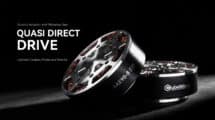Harvard’s soft exosuit team has recorded a new metabolic cost reduction record of 23% when using their soft ankle exoskeleton. This is a new record that probes the Wyss Institute’s soft exosuit limits. The full study will be published as the cover article of Science Robotics (robotics.sciencemag.org).
A test group of seven able-bodied individuals was fitted with a new revision of the Wyss Institute soft exosuit. The exosuit is composed entirely of soft materials and has no load bearing capability. It is attached to the ankle and but the force transmitting elements (Bowden cables) go through the hips, creating a weak hip-ankle coupling. The users demonstrated a maximum relative reduction in the metabolic cost of walking (with the suit on in both cases) of almost 23% compared to the suit being turned off. More precisely, 22.83 ± 3.17% relative to the powered-off condition (mean ± SEM). This is a limitation of the study because it used a suit powered off baseline (control) rather than a suit entirely off condition.

This metabolic cost reduction is only relative. It does not take into account the weight of the controller, batteries, or cooling elements. This experiment measured only the cost of walking – assistive force rather than the cost of walking + cost of exoskeleton – assistive force. Why would anyone do that? If you remember Steve Collin’s presentation on Prosthesis and Exoskeletons from 2015 he outlined the advantages of breaking exoskeleton research into modules. One module would be the controllers, batteries, fans,… the things that are classical robotics, and one module would be the wearable component that is attached to the user. This method allows for rapid prototyping, many times faster than making a full wearable robot for each test. In addition, any changes to the experimental results can be attributed to the exoskeleton, as everything else is off the user, sitting on a shelf next to the test subject (usually connected by electrical and Bowden cables). Decoupling the soft exosuit from its power and control modules has allowed the Wyss Institute and their collaborators the opportunity to run rapid prototyping to the test the limits of their device.
Another interesting observation is that the users in the study adjusted their gait pattern proportionally to the increase in assistive force. This phenomenon has been observed in other similar studies as well. It throws a wrinkle in exoskeleton research as test subjects have to be given sufficient time to adjust to the wearable’s assistive force before any experimental values can be recorded.
What’s next for the exosuit?

The authors of the study are now interested on what is the maximum benefit a full body (or at least full lower body) wearable could have. However, this will have to wait for another study and most likely, a redesign of their wearable robot. In addition, the study does not report a leveling off effect, so it is possible that this version of the exosuit is still not utilized at its peak performance. These experiments are quite valuable since it is not clear how much a soft exoskeleton with no load bearing capabilities can do. We don’t know the limits of this technology, but this study is demonstrating some very encouraging results.
What is next for ankle exoskeletons?
Ankle exoskeletons, be it passive or active, are an interesting breed of wearables. They run counter to the majority of medical assistive and rehabilitation gait exoskeletons that focus on the hips and knees. Ankle devices are derived from the idea that while the hips are instrumental in swinging the leg forward, a lot of the push off energy in each step is generated at the ankle and stretched muscles and ligaments behind it. For more details, refer to the video by Greg Sawicki on Successfully Reducing Walking Metabolic Cost.
Ankle exoskeleton research comes in all shapes and actuation strategies. Lumping the research of multiple labs together, there are ankle wearable devices that are powered with: springs and clutches, pulling cables, electrical motors, electrostatic sheets, air muscles, and twisting ropes. And these are just the ones that we know of!
Conclusion
Soft exoskeletons and exosuits can appear a bit strange at first because they don’t have the capability to support their own weight. Their construction directly contradicts the term “exoskeleton,” as they are not external rigid devices but soft and malleable. This is why they are most commonly referred to as exosuits. The current study by the Wyss Institute, Harvard John A. Paulson School of Engineering and Applied Sciences, DARPA’s Warrior Web Program, National Science Foundation, Samsung Scholarship, São Paulo Research Foundation and the Robert Bosch Stiftung explored the potential and limitations of exosuit technology using proven rapid prototyping techniques.
There are many potential applications for this technology. The exosuit could be used for power amplification or to improve the symmetry in the gait cycle (for example, from paralysis on one side of the body due to stroke). The exosuit could be applied to healthy individuals who are overburdened by a large load (soldiers) or those suffering from muscular or cardiovascular weakness (the elderly).
Sources
Wyss Institute, Soft exosuit economies: understanding the costs of lightening the load, January 18th, 2017, https://wyss.harvard.edu/soft-exosuit-economies-understanding-the-costs-of-lightening-the-load/
Full Paper: Assistance magnitude versus metabolic cost reductions for a tethered multiarticular soft exosuit, http://robotics.sciencemag.org/content/2/2/eaah4416.full








Curious to see what the suit completely off the user would do to those metabolic number
This came up for discussion during the Exoskeleton Technical Interchange Meeting. How do you get labs and companies to release all of the results, including those that will be lower?
23% would have my polio/post polio damaged lower leg at almost 75-100% levels .. better than any AFO will do. Wish they would be available soon before I have to go to KAFO due to the additional strain on upper leg muscles burning out the neurons there.
Hello, Melissa, To my understanding, ReWalk Robotics is currently developing a commercial version of the Wyss Soft Exosuit under the name “Restore.”